Some web browsers used to offer built-in features to edit and publish web pages.
You could edit any web page. Modify the text, the formatting and styling, attach images, link to another page...
After having done these changes, you could publish them to the web server so that others can see your contribution.
I'm going to highlight that this was only possible for a limited period of time, on browsers with a limited audience.
WorldWideWeb (1990-1994)
The Web was originally created within a European research lab called CERN, European Organization for Nuclear Research.
This is where was developed the very first browser called "WorldWideWeb".
The original documentation pages are still available online!
The following quote highlights the read and write capabilities of this browser.
The "WorldWideWeb" application for the NeXT is a prototype Hypertext browser/editor.
source
The main author of this application, Tim Berners Lee also insists about the editor aspect in this retrospective:
The first web browser - or browser-editor rather - was called WorldWideWeb [...]
source
And another time in this note:
If you think surfing hypertext is cool, that's because you haven't tried writing it.
source
In 2019, the CERN organized a project to rebuild WorldWideWeb using today's web technologies. While doing so, they published a website describing the original vision of the Web and its related browser application in details.
This website also insists a lot about the editor side of the browser:
Today it's hard to imagine that web browsers might also be used to create web pages. It turned out that people were quite happy to write HTML by hand—something that Tim Berners-Lee and colleagues never expected. They thought that some kind of user interface would be needed for making web pages and links. That's what the WorldWideWeb browser provided.
You can test this browser on this project web page. This works slightly better on Chrome than Firefox, but I must warn you, it is quite buggy. There is many cursor issues.

Nonetheless, it is quite stunning to see how this browser actually works.
You can move the caret anywhere, in all the web pages, and modify the text anywhere.
Do some basic styling, copy and paste text, ...
Exactly like Microsoft Word / Google Docs, but against remote web pages!
But... it had some serious limitation.
While you can edit all the pages, you could only save your changes to local files.
You could edit, but not publish your changes.
This is mentioned on this documentation page about how to create a new page:
You can edit existing documents using WWW so long as they are files. You cannot normally edit information retrieved from remote databases.
source
This actually relates to some implementation detail, which was clarified by Tim Berners Lee:
It would browse http: space and news: and ftp: spaces and local file: space, but edit only in file: space as HTTP PUT was not implemented back then.
source (I will followup about this in another blog post)
None of the future browsers ever re-implemented such behavior: editable by default.
Mosaic (1993-1997)
The second most notable browser, "Mosaic", drastically changed the vision of the Web.
You could only open and browse HTML pages. All the editing features disappeared in this browser.
This introduced the URL bar which wasn't visible in WorldWideWeb.
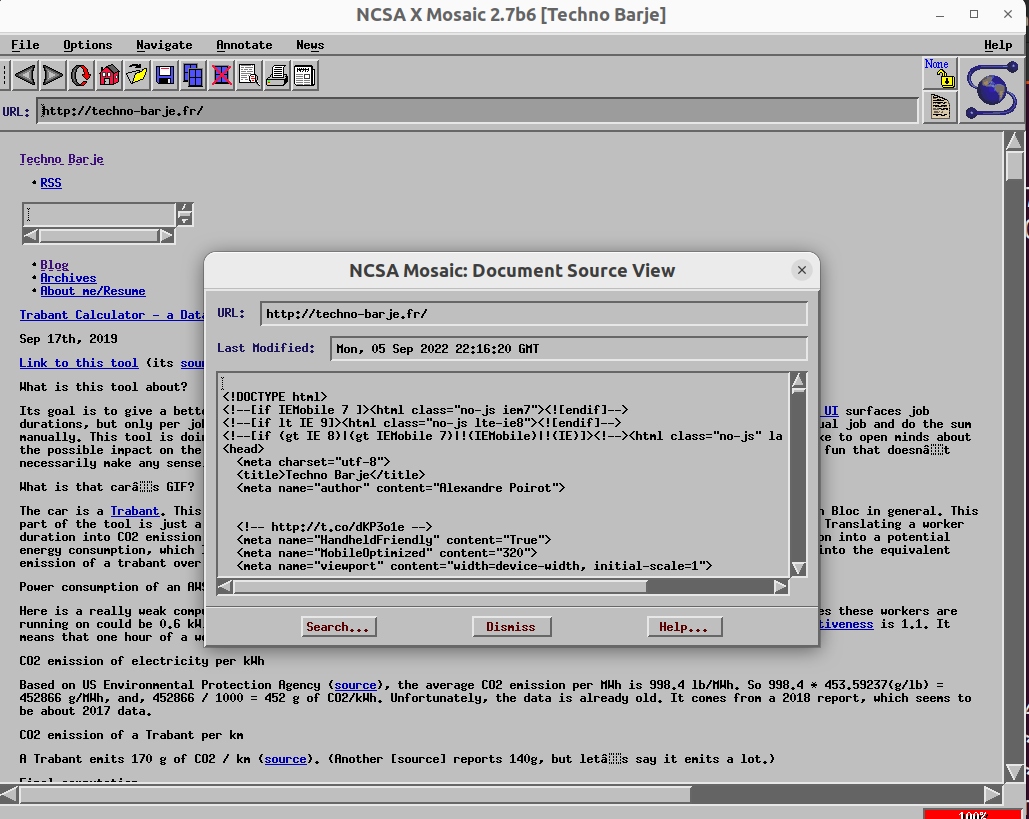
You could only open the HTML sources internally (via view source feature), or via an external editor application. Source code
Mosaic influenced much more the long term future of web browsers. Looking at its UI, you can see that it is very similar to today's browser UI.
Note that you can run Mosaic on Linux! But you have to build it from sources available on GitHub. It can easily fail building, but see this issue to address the failures.
Early Netscape versions up to 2 (1994-1996)
"Netscape" started being released one year after the first version of Mosaic. Netscape took the lead on being the most popular browser, but still didn't reimplement page editing in any way.
Screenshots for Netscape Navigator 2
Netscape 3 (1997)
Netscape 3, via the Gold edition, shipped the "Netscape Editor" feature.
Pressing "Ctrl-E" would allow you to edit any page in it!
You could then save your modifications in a local file, but still not publish it to the remote server.
You could edit, but not publish your changes.
This was really similar to the behavior of WorldWideWeb browser, except that pages aren't editable by default.
The editing had to be done within a distinct application/window.
Netscape 4 (June 1997-2000)
Netscape 4 started exposing a publish feature while renaming "Netscape Editor" into "Netscape Composer".
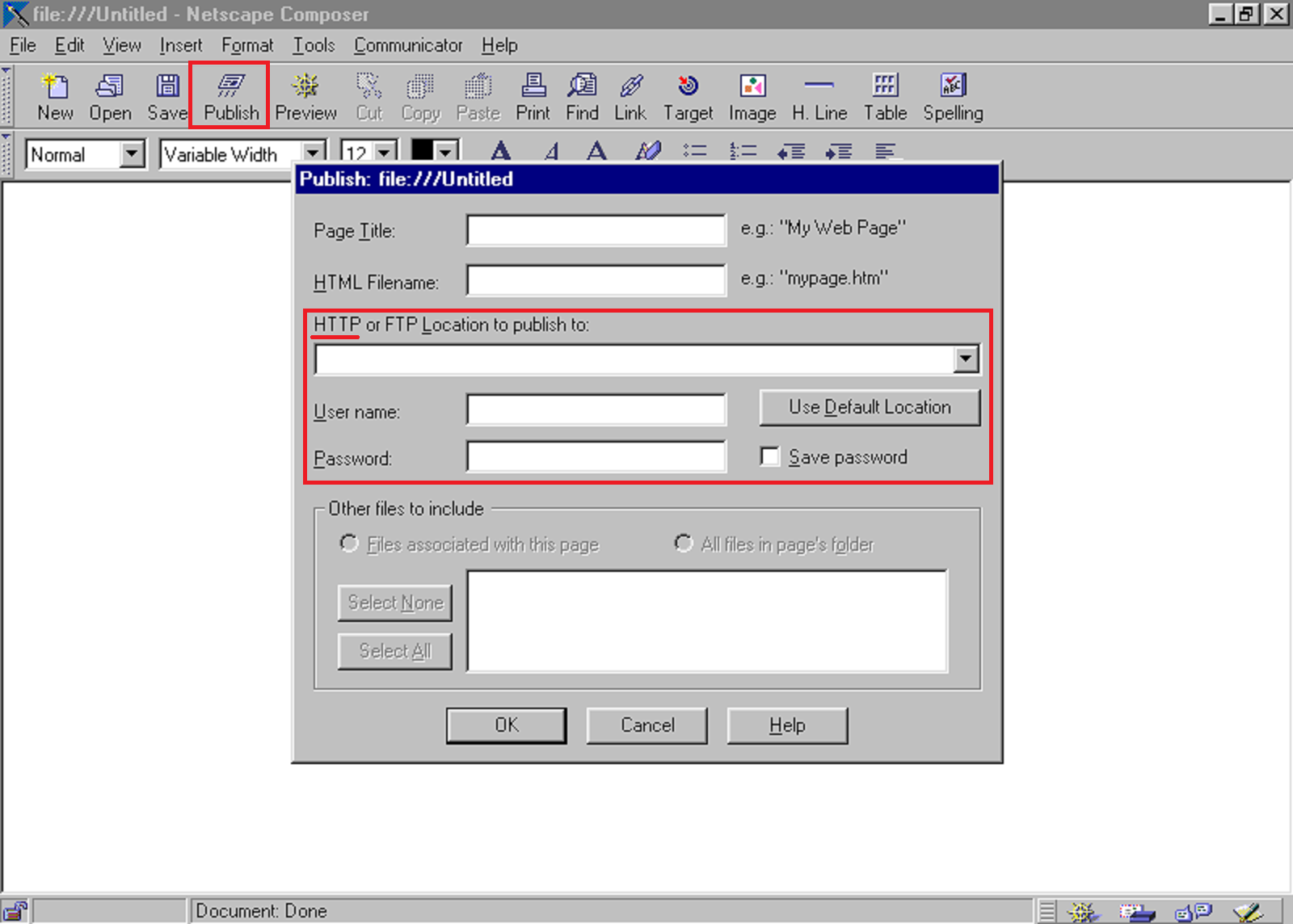 Notice the HTTP -or- FTP upload methods. (I'll followup about the HTTP upload method in a another blog post)
Notice the HTTP -or- FTP upload methods. (I'll followup about the HTTP upload method in a another blog post)
This finally addressed the shortcomings of WorldWideWeb browser.
We could easily publish the changes we just made on the page, as soon as you had the necessary
credentials on the remote web server for uploading files.
Unfortunately, this is also the last popular Netscape product. Netscape had 80% market share in 1997, but only 13% in 2000! 1st source 2nd source
Netscape 6 (2000-2002)
Note that Netscape 5 was never released. The version was dropped in favor of Netscape 6.
Surprisingly Netscape 6 dropped the publish feature from Composer:
 Thus, getting back to the behavior of Netscape 3.
You can edit changes locally, but you can no longer publish the changes to the web server.
Thus, getting back to the behavior of Netscape 3.
You can edit changes locally, but you can no longer publish the changes to the web server.
Mention in Netscape 6 troubleshooting:
Problem: The Editor application does not support the Publish feature. source
Netscape 7 (2002)
Surprisingly again, Netscape 7 revived the publishing feature in Composer:
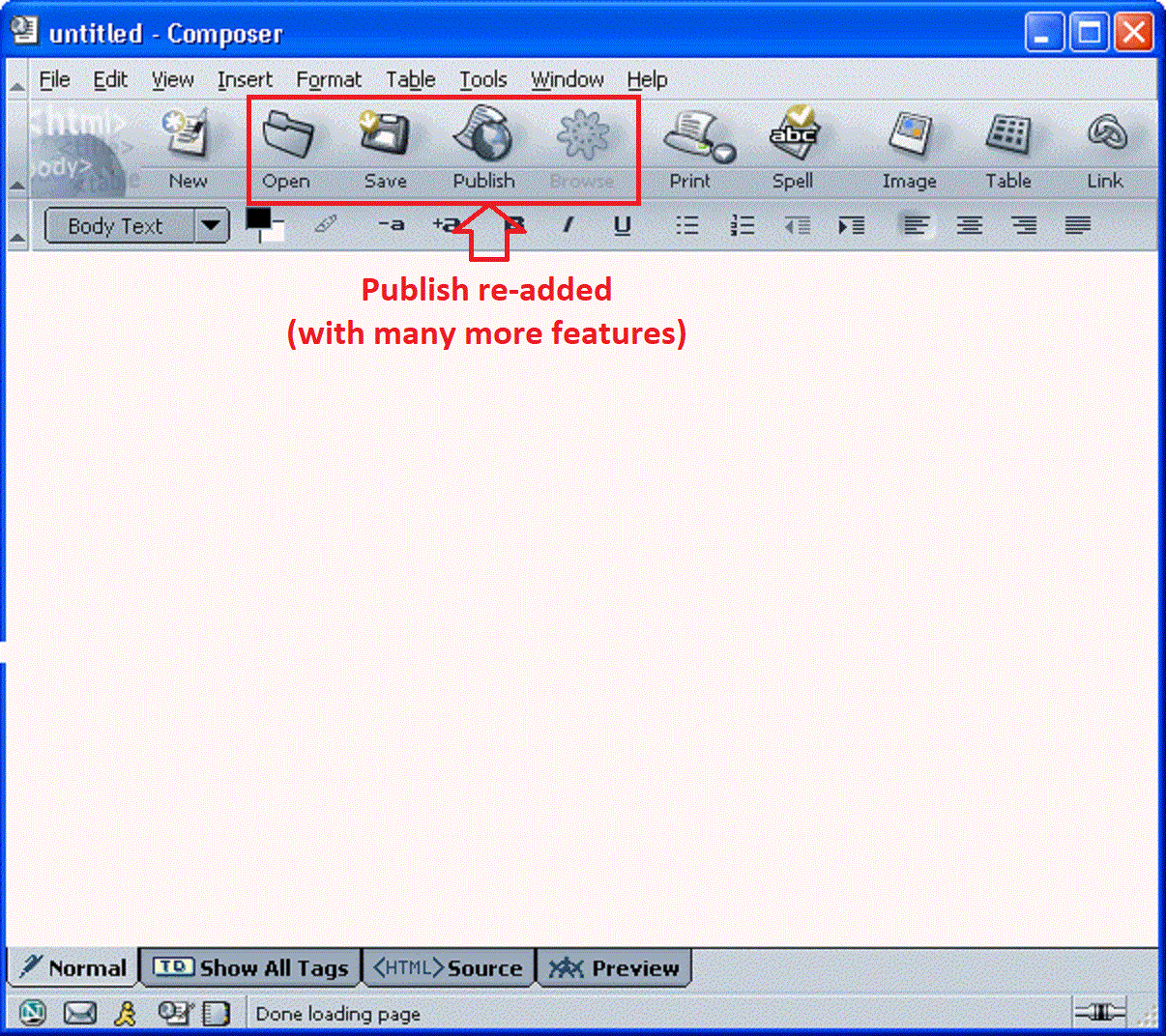 But at this point, netscape was under 4% in market shares.
source
But at this point, netscape was under 4% in market shares.
source
The complex history between Netscape 4, 5, 6 and 7 is probably related to the move of Netscape to an open source codebase. This was initiated by the Mozilla project, which started in 1998, one year after the release of Netscape 4. source This may be the reason why the version 5 was cancelled and why some features were dropped in Netscape 6.
On the plus side, today, we are able to track the development of the publishing feature which was re-implemented from scratch in the open source codebase. The latest version of Netscape 6 was based on Mozilla 0.9.4.1. source The feature was tracked by this bugzilla ticket, the first patches landed into Mozilla 0.9.7 (November 2001) and the very last patch landed into Mozilla 1.0 (March 2002). Netscape 7 was later released in August 2002 based on Mozilla 1.0. source
Browsers landscape from 2002 till now
In 2002, "Internet Explorer" had already around 90% of market shares. And Internet Explorer did not have any editing capabilities.
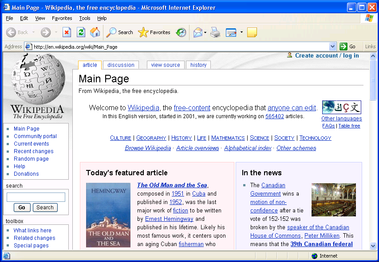
A few years later, in 2006, the first "Firefox" version was released and also focused only on browsing and reading the web (Like Internet Explorer).
"Netscape Composer" was never reintroduced in Firefox.

In 2008, "Chrome" doubled down on stripping down browser features and UI to delegate even more capabilities to the websites.

Bonus: Seamonkey (2006-today)
A browser still exists today, in 2023, with web page editing and publishing, exactly like Netscape 7!
Believe it or not, but a group of contributors are maintaining the original open source codebase of Netscape over the decades!!
This browser is SeaMonkey.
Like Netscape, it includes: a Web browser, but also a mail reader (ThunderBird), a newsgroup reader, IRC chat, and last but not least, one HTML editor (Composer).
This project is still active and released a new version in September.
I encourage everyone to give it a try. This is really amazing to see all these old and complex softwares still working today. It is also the easiest way to run a Web browser with full editing and publishing support on modern computers. The icing on the cake is that, as it is based on latest version of Gecko (the Web engine of Firefox) it benefits from almost the same support of Web standards as Firefox.

Conclusion
Web page editing and publication features through the browser UI was only exposed to a wide audience during three years (1997 to 2000). It was actually even shorter than that as it was during the Netscape 4 era, where their market share fall part.
I'll investigate in a following blog post how different WorldWideWeb's vision of the web was compared to all subsequent browsers. And the consequences it had on how the Web is used starting from Mosaic.
Overview of browser history
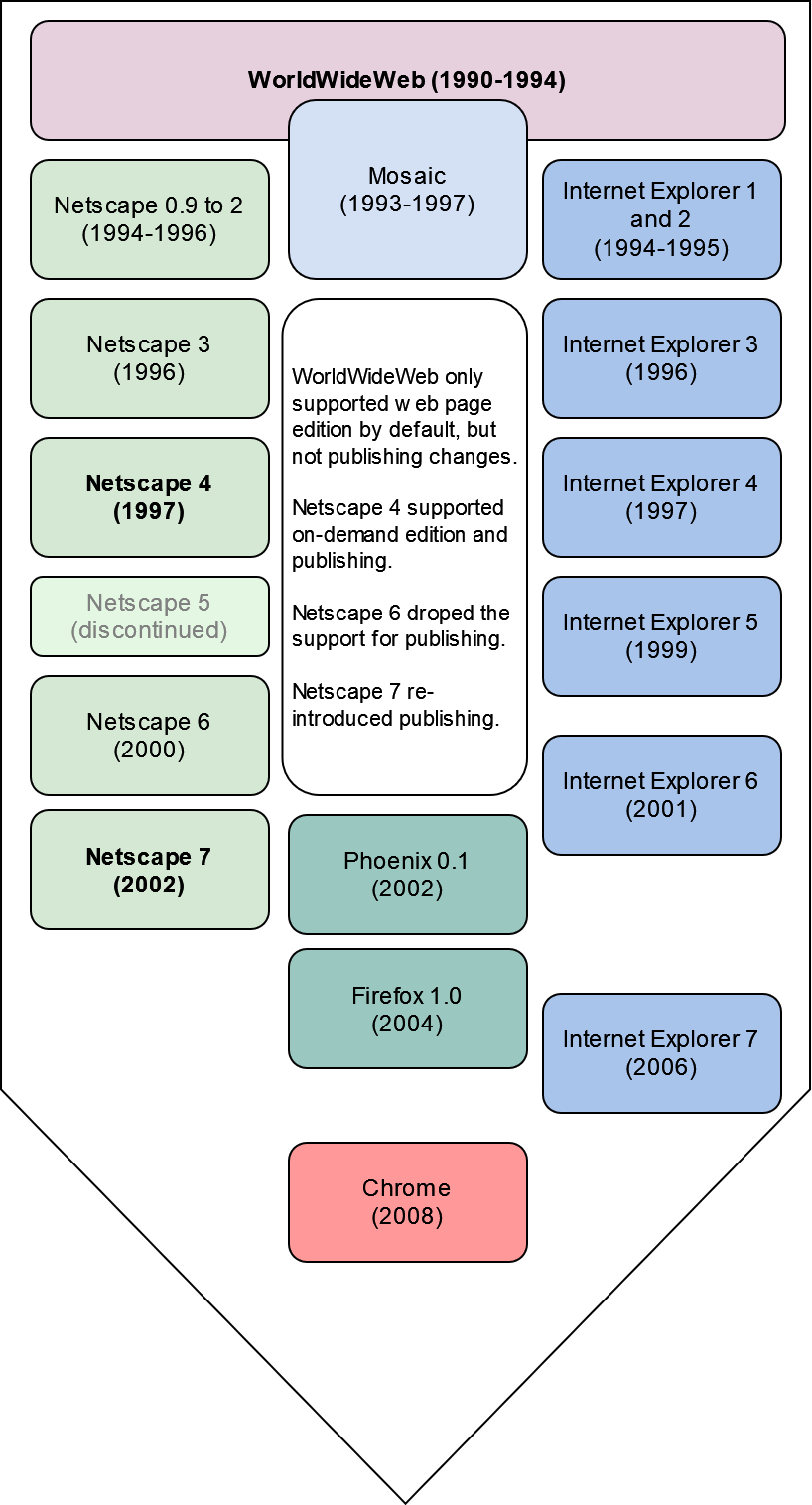

Comments
You can use your Fediverse (i.e. Mastodon, among many others) account to reply to this post
(Note that comments from locked accounts won't be visible on the blog, but only to me)